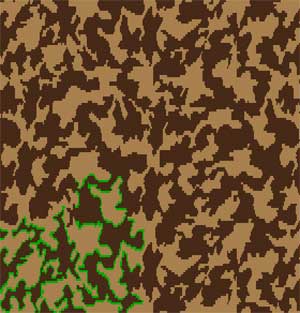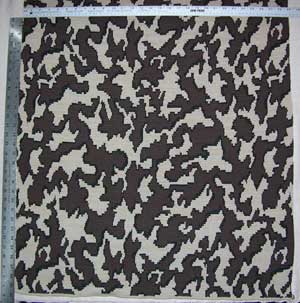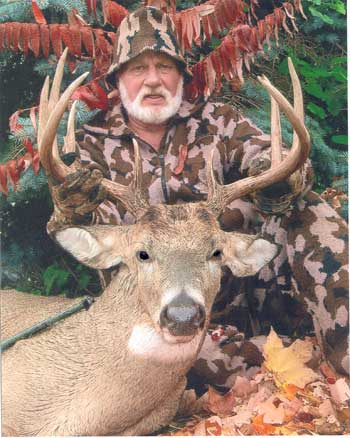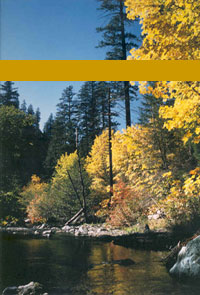Camouflage Clothing for Hunting and Knit Yarn Properties
Follow the Steps in Designing the Knit Camouflage Fabric and Graphic Design that Works for Hunting
By Sharon Nani written in 2006 (updated March 17, 2011)
Note: Bob Fratzke was honored once again in September 2016 for his
significant contributions to archery businesses and the sport of archery & bowhunting in the past decades. Bob was inducted into the Minnesota Archery Hall of Fame. And yes, he is still actively hunting for those Trophy Whitetails. Congratuations to Bob from all of us at The Knit Tree, and special thanks for sharing your knit Winona Camo System with us so we can still offer it to the supporters of Winona Camo products. Read more about it at the Minnesolta Archery Hall of Fame web page.
Hunters know the importance of unique requirements for camouflage clothing and their hunting environment. Graphic designs put together with wool and wool blend yarns can create a fabric that can fill these special needs. This article will take a look at some of the considerations in developing a camouflage knit fabric with the ‘hunter in mind’. It will also give you some insight in the process The Knit Tree goes through for a client with a personalized request along with a discussion of wool and acrylic yarn properties.
Click on the following links to go directly to the topic of choice:
Request for the Knit Camouflage Pants and Camo Sweater Sets from a Bow Hunter
Why a Wool and Acrylic Blend of Knitted Material?
Yarn Properties of Turbo Acrylic
Blend of Merino Wool and Turbo Acrylic for Camouflage Knit Clothing
Why does a Bow Hunter Wants Merino Wool Camouflage Clothes Blended with Acrylic Yarn?
Graphic Design and Camo Pattern Color-ways?
The Client’s Graphic Camo Pattern Requirements
Drafting the Pattern Block for the Camo Clothing for Hunting
NOTE:Click on all images to see an enlargement of the photo!
Designing Knit Winona Fabric and Graphic Pattern for Hunting
The Knit Tree is Licensed to Bring Back the famous Knit Winona Camouflage System
Originated by Bob Fratzke
March 2011 Update: We are honored and pleased to announce that The Knit Tree is licensed to Use the famous Winona Camo Patterns and to recreate the Winona Camouflage clothing and accessories. We refined the camouflage pattern below and substituted it with the Winona Camo Classic©, Winona Camo Elite©, Winona Camo Snow© and Winona Camo Blaze©, all originated by Bob Fratzke. Go to our Online Catalog along with several articles that are written about Bob Fratzke and his Winona Camo hunting garments.
Please read my articles Winona Knit Camo© Ridge Runner Cap ~ Originated by Bob Fratzke and Reconstructed by The Knit Tree; to see this development process of reconstructing the Ridge runner Hat, the article " Compare Winona Knit Camo System to The Knit Tree's Knit Camouflage Clothing" to see the steps in reproducing the Winona hunting jacket classic cardi submitted by Grainger. Click here to read the article about Bob Fratzke and the history of Winona Camouflage Knit Clothing and Accessories and the article Winona Color Ways show samples of the variety of Knit Winona Camouflage Color ways offered in The Knit Tree's online store catalog.
Many thanks to Bob Fratzke for send me his samples and photos so I could get the design and construction right for all the hunters that have been waiting for the return of Winona Camo Knits.
Winona Camo Cardi Jacket in Classic and Elite, Winona Camo Ridge Runner hat in Classic and Elite, Winona Camo Fleece Lined Vest in Classic and Elite and many more on the way.
Many thanks to Bob Fratzke for send me his samples and photos so I could get the design and construction right for all the hunters that have been waiting for the return of Winona Camo Knits.
Request for the Knit Camouflage Pants and Camo Sweater Sets from a Bow Hunter
The Knit Tree specializes in ‘personalized knits’. Therefore, we often get requests from individuals who are looking for that special knit item that they have not found elsewhere. Development of our 3-Color camouflage graphic pattern in 2006 and our merino wool and acrylic blend yarn for our jacquard fabric were inspired by such a request.
The process usually begins with an email to customer service. Matt Howe, from Michigan and an avid bow hunter, contacted me that he had been searching the internet for knit camouflage pants. He knew that some had been made years ago by Winona (see current copyright and licensing acknowledgement), but these were no longer being made in 2006. He found Mossy Oak™ and Realtree™ imported sweaters at Cabelas, but these were 100% wool fabric. What he really wanted was a knitted fabric with wool and acrylic blend. And although he liked the camo pattern in one of The Knit Tree’s camo visor caps,- the digital block camo pattern created by The Knit Tree in 1972 -- he would prefer some alterations to it. It also appealed to him to have something custom knit and hand loomed in the United States to meet his special requirements.
Well, all these things were quite reasonable and possible so the process evolved.
Why a Wool and Acrylic Blend of Knitted Material?
First ‘Why Knit Material’. Matt explained that in his opinion, silent camo clothing was essential in bow hunting, or any hunting for that matter. Knit camouflage clothing would meet this requirement because knits are very quiet upon movement.
Second, the blending of different percentages of wool and acrylic can take advantage of the properties of both of these yarns to make the weight, drape, and characteristics desired for camo hunting clothing. Combinations of yarns are often combined in order to make a ‘compromise of the advantages and disadvantage of a fiber’ to result in a unique fabric that is suitable to the needs you are trying to accomplish.
Yarn Properties of Wool
To understand why a wool and acrylic blend yarn would be valuable, I will discuss some of the yarn properties of these fibers. Wool is always a desired ingredient in camouflage clothing for its warmth and insulating properties. We also want all of our knit wool or fiber blend products to be soft and comfortable next to the skin. ‘Merino wool’ is the finest and most comfortable wool. Merino Sheep at about a year of age produce a staple length of 2 to 3 ½ inches in length. The shorter staple lengths make the softest yarns. Of course the softness of the yarn is also affected by what part of the sheep it came from, the climate the sheep lived in, the food it ate, and even the stage of life at the time of sheering.
If, we even take a closer look at these fibers under a microscope we would see the wool’s natural crimp which looks like tiny scales. It is here that tiny pockets of air are trapped. It is these pockets of air that give yarn the ability to ‘insulate’ or keep the body warm in cooler temperatures, and cool in warmer environments.
The property that wool holds moisture well has the advantage of comfort by insulating as explained above, but that same quality aids in the disadvantage that it takes along time to dry and holding the moisture will also make the fibers shrink in length. This is one of the reasons why washing pure wool clothing is not recommended. Another factor about the natural merino wool that should be considered is that it could be affected by moths and mildew.
Yarn Properties of Turbo Acrylic
This is where adding the turbo acrylic comes in as an advantage in this blending process of the wool and acrylic fiber. Turbo acrylics used by The Knit Tree’s hand loomed knits are artificially treated to have ‘crimp’ or bulk. This helps them have the same advantage for insulating comfort as our merino wool. In fact, they can have more insulating power than wool - with less weight. But it does not hold moisture as well as the natural fiber of wool. This property by itself would lend to the fact that acrylic doesn't’t breath to release the heat in warmer temperatures. On the other hand, in a wool acrylic blend this would counter balance the shrinkage problem and allow you to hand wash your garment in cold water, then laying it flat, it would dry more quickly than a pure wool fabric. Also, acrylic is lighter in relative density than wool, and those two fibers together will have a better drape, the ability to stretch and move quietly with the hunter. Another advantage of adding acrylic yarn with merino yarn is that the acrylic is a stronger fiber making the combination more durable than the merino yarn alone. Acrylic yarn is even more durable and easier to care for because it is not affected by moths or mildew and can be machine washed in cold water.
Blend of Merino Wool and Turbo Acrylic for Camouflage Knit Garments
So it is that the yarn chosen for The Knit Trees camouflage clothing ‘with the hunter in mind’ is varying percentages of merino wool blended with our high grade turbo acrylic yarn. The more wool in the percentage factor, the heavier the garment and the stronger the wool properties will become or visa versa where the blend is larger for the acrylic.
These yarns are knit in a jacquard double bed fabrication. This also aids in blending the merino wool yarn strands with the acrylic yarn strands to produce a very stable fabric with good drape and great combined yarn properties.It has a stitch gauge of 10 stitches and 26 rows in one inch of knit jacquard fabrication to make the camo fabric tight enough for camouflage clothing, but yet give the stretch of knit fabric.
In summary, the wool adds comfort, insulation, warmth and the ability to hold moisture. Acrylic adds durability, insulation, stabilization of the shrinkage factor, drape, and wash-ability. These yarns together with the jacquard fabrication make a great blended fabric which will stretch over your layers and quietly move with you as you hunt, and keep you comfortable as you are stationery in your hunting blind.
This is a great silent camo clothing fabric to add to your hunting accessories.
Update Note: by 2011 Enough of this camouflage Wool/Acrylic blend has been sold to give the additional care instructions of: wash on gentle / cold water with a mild unscented detergent. Dry on low heat in a dryer for about 10 minutes, remove while still damp and lay flat to dry the rest of the way..
Why a Bow Hunter Wants Merino Wool Camouflage Clothes Blended with Acrylic Yarn
When bow hunter, Matt Howe was asked, “Why are you requesting merino wool camo clothing with a blend of acrylic yarn for your personalized camouflage sweater and camo pants?” This was his answer:
Silence is of utmost importance. Silent fabrics available are cotton, poly cotton blends, fleece, acrylics, and wool. Cotton is probably most quiet but impractical for hunters in cold climates. Cotton once wet through sweat,rain,snow, chills the body. Same for cotton poly blends. Fleece is hard to keep looking nice over time, and although it dries quickly, it sucks up water while hunting. Since it's not cotton, it does still insulate Wool is perhaps the best hunting fabric, but 100 per cent wool garments are prone to shrinking, itchy ness, and are often very expensive, plus most are dry clean only which is impractical for a hunter. Wool is the only fabric that insulates even when totally soaked with water. A wool and acrylic blend is silent, affordable, and still insulates when wet. A value hunters dream fabric. Only draw back of knits is there snag ability while walking amongst sticks and prickers. They are also prone to hitch-hiking seeds, but almost all camo fabric is prone to picking up those dang critters.
Why 3 Color Graphic Design and Camo Pattern Color-ways?
Now, that The Knit Tree’s hunting client, Matt, was happy with the fabric weight and merino wool and acrylic fabric blend – it was time to consider the camouflage graphic pattern.
Even back in 1940, when James P Miles, David Nani’s grandfather, and writer for the hunting magazines of the time: the “Outdoorsman” and “The American Rifleman” saw the importance of camouflage clothing. In his article “Deer of California”, September Issue 1940 of the “Outdoorsman”, he stated: “That a deer’s sight is very keen, there can be no doubt, especially in a poor light, when its superiority over human vision is asserted. But one peculiarity is very noticeable. Whereas they instantly detect movement, they sometimes seem baffled to identify stationary objects. It is therefore well when hunting deer to wear neutral colored clothing, which blends with the background.” (Note: This article had wonderful information about “Deer of California’ and hunting tips, so I will share it with you in its entirety with the original wildlife photos in a separate pdf file.) Another fact about most mammals, including deer, is that unlike humans, they do not have ‘color vision’, but they certainly can detect the outline of a human figure.
Matt has these added comments: "they certainly can detect the outline of a human figure. Therefore breaking up the human silhouette should be the main objective of camo clothing, not matching the surroundings of every hunting habitat 'perfectly' because you would need a dozen plus camo patterns to do this. Make one good break up pattern, and vary color scheme. This is a much better approach.
camouflage color ways. offered by The Knit Tree present day in the Winona Camouflage Graphic pattern originated by Bob Fratzke and licensed to The Knit Tree.
The Client’s Graphic Camo Pattern Requirements
Matt took this a step further when he stated that the camouflage patterns for the acrylic camo fashion sweaters were really ‘too tight to be useful for hunting. And this is very true, because they were originally designed as a fashion camo to accent the Native American Designs and for paint ball enthusiasts who like to play war games. Matt would really like a camo pattern more suitable to the true needs of hunters. A larger graphic that broke up the human outline image would be better. He also wanted an element of black in it to depict the shadows found in nature.
Graphic Pattern Set Up
Sharon Nani, owner of The Knit Tree, loves working with graphic designs aided by the use of a computer software program “Stitch Painter’ by Cochenille. You can insert the stitch and row gauge for the new blend of merino wool and acrylic fabric into Stitch Painter. This makes a visual grid the size of your real knit stitch.
Then a color pallet is made to match the colors of yarn chosen for the camouflage fabric. It is important to see the graphic design in the camouflage color ways and in the correct proportional size as visualized on the actual clothing. A canvas on which to paint is established in the size of an average sweater front without trims (25” x 25”) so that the graphic images which are drawn can be visually seen as if on a garment. Particular attention is paid to how this graphic pattern will repeat on all four sides on larger pieces of fabric. Susan Lazear, owner of Cochenille, has written an instruction book on how to develop these repeating graphics called “ Designing Repeat Patterns by Computer”
Drawing the Camouflage Design
The ‘fun’ begins: First important concepts of camouflage must be considered. Camouflage must have the ability to hid or ‘break up’ the visual of the human body. Hard vertical lines can draw attention to the object; therefore, they should be avoided. Neutral colors of nature of the hunting environments are good to use and should meld together. An illusion of a 3 D objects might add to the breaking up effect. And finally, the shadow as in nature effect that Matt desired is all taken into consideration.
A three color fabric, with each color containing a strand of merino wool and a strand of acrylic is already determined to be the clients desired fabric weight. Inspiration for a camouflage pattern can easily come from looking at the superimposing effects of various leaves in a forest setting or other hunting settings.
Sharon’s interpretation of two blending colors in a maze of leaves effect and lined by a dark color shadow of thickening and thinning lines is the resulting graphic camo pattern. See the results in the “3-Color Camouflage” Sweater and Camo Sweat Pants offered to you in The Knit Trees Online Catalog.
Creating a Camouflage Pattern Repeat
Camo Graphic from 2006 Replaced in 2011 with Winona Camo Graphic

Drawing the 3 color camo pattern

the final camo yardage
The Stitch Painter Software by Cochenille was used to draw the camouflage pattern in 2006. The partial drawing to the left shows how the camo pattern started as a two color design, then the green color was used to create a shadow between the other two colors. Matt reviewed this and said 'the even outline was too rigid and would be better if it had thinning and thickening lines. After the pattern drawing was complete, the repeat was created for height and width. Finally, the green color was changed to black for the shadow.
The photo of the 2006 camo yardage to the right shows the size of the repeated camouflage fabric. The width ruler shows fabric measures 29" The height ruler shows fabric measures 29". This yardage would be big enough to simulate the front or back of most upper garment pieces of 3x.
March 2011 Update: We are honored and pleased to announce that The Knit Tree is now licensed to Use the famous Winona Camo Patterns and to recreate the Winona Camouflage clothing and accessories. We retired the camouflage pattern above in the first 2 photos and substituting it with the Winona Camo Classic, Winona Camo Elite, Winona Camo Snow and Winona Camo Blaze, all originated by Bob Fratzke in our Camo line of clothing and accessories. Go to The Knit Tree's Online Catalog to purchase any of the Winona Camo hunting garments.
Drafting the Pattern Block for the Camo Clothing for Hunting
Sharon Nani uses another one of Cochenille’s computer software programs as a design aid for pattern drafting. It is like an ‘Auto Cad’ for garment design pattern blocks. You can completely control your desired changes from the standard garment industry pattern blocks to create the sewing and shaping blocks for your knit or sewing pattern. Read more about this program Garment Designer, at Cochenille’s web site.
The upper garment sweater blocks used by The Knit Tree have been used for over 30 years, with variations to meet the styles, fashions, or utilitarian needs of the day. And legging or pants have been made for ladies and babies in the fashion industry also for years. But this was a new challenge to meet the needs of our client, Matt, for his request of knit camo pants to be worn over layers of other garments. His comment that his existing fabric camo pants ‘rode to low’ over his layers when he was in his stationery hunting positions and resulted in ‘unwanted drafts’. Matt’s specific measurements and needs were taken into consideration as the pattern block for his specific camouflage pants were drafted.
After confirmation that Matt’s Camo Pants met his expectations and requirements, the pattern block was graded for the standard sizes. These garments are ‘Knit to Order”. Therefore, alterations for inseams, waist and hip variations can be met for the individual. Check out our Knit Camouflage Camo Cargo Pants in our online knitting catalog and enjoy having special camouflage hunting clothes especially knit for you too!
Copyright and Licensing Acknowledgements
"All Winona Camo items by The Knit Tree are produced under license derived from Copyrights originated by Bob Fratzke."
informational Credits are given by The Knit Tree to the following:
“Yarns for the Knitter” The Thorn Press Tessa Lorant, 1980
“Handbook of Timesaving Tables for Weavers Spinner’s and Dyer’s Bettie G. Roth & Chris Schulz 1983
“Deer of California” Sept. 1940 Issue of “Outdoorsman Magazine” written by J.P. Miles
Matt Howe, avid Bow Hunter, from Grand Rapids, Mi. 2006
The Knit Tree Specializes in Personalized Knits. These Knit Camo Pants and Camouflage Sweaters are knit with Camo Clothing for Hunting in Mind
Visit us on facebook too ~ page is in development



